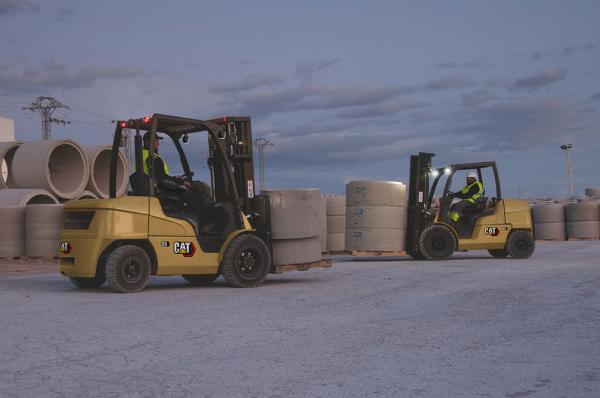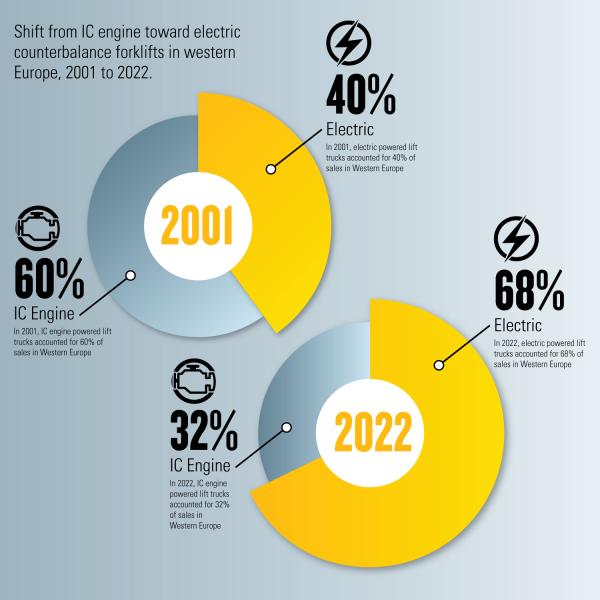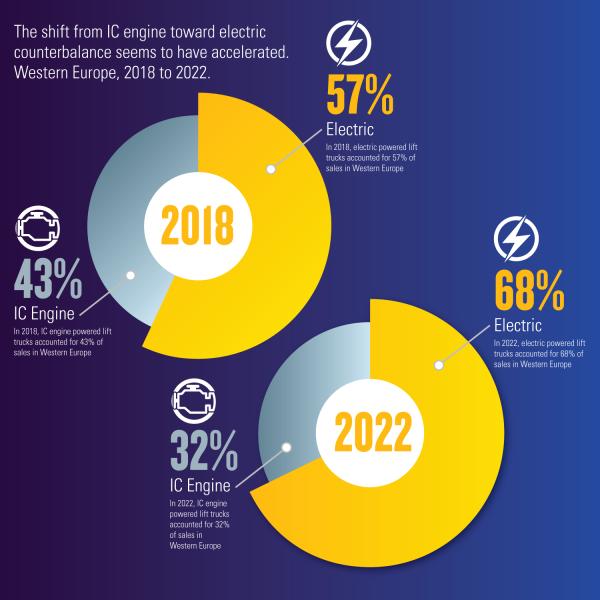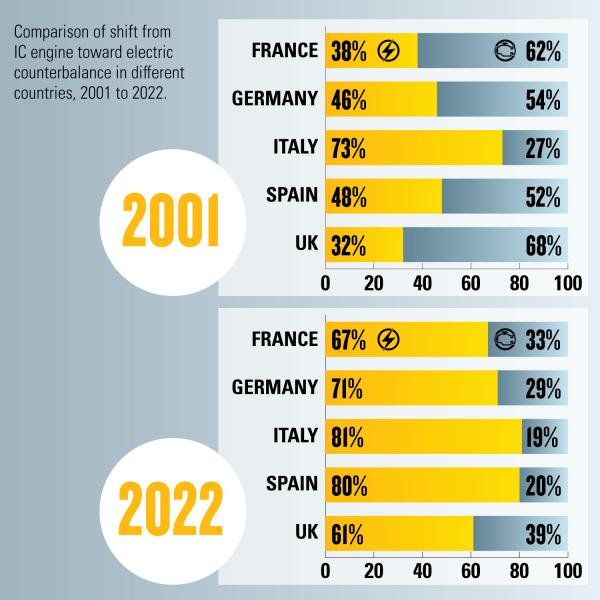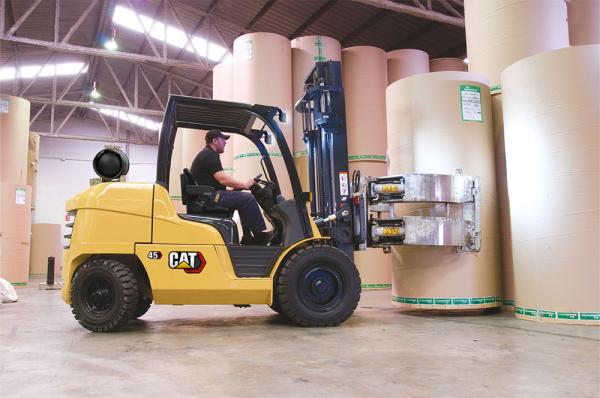Cat® Lift Trucks maps the electrification trend but highlights a continuing demand for diesel and LPG forklift trucks.
Counterbalance forklift sales trends
Within the last 20 years we have seen IC engine counterbalance forklifts lose their dominance in western Europe’s market. Sales have flipped from 60:40 in favour of IC engine in 2001 to a 32:68 advantage for electric in 2022. This is the last year for which full data is available at the time of writing (See Figure 1).
In fact, the trend seems to be accelerating. (See Figure 2.) The increasing urgency of energy transition is a major factor. More recently, fuel price instability caused by armed conflicts has added to the appeal of alternatives to gas and oil.
Comparison of trends between countries suggests cultural differences in preferred power sources. However, within western Europe those differences look smaller today than in 2001. (See Figure 3.)
The picture is likely to be very different, culturally, in eastern Europe, and even more so on other continents.
Figures comparing diesel and LPG forklift shares within the IC engine segment are not so easy to obtain. We do know that European customers have always leaned more toward diesel, while Americans are amongst those who have preferred LPG. As the pressure to reduce emissions increases, some diesel users may move to LPG. But most of those who switch will probably go directly to electric.
LPG and diesel forklift challenges
The competition from electric counterbalance forklift trucks is intensifying. In addition to eliminating tailpipe emissions, they offer many other advantages. See our full explanation of these. Meanwhile, electric forklifts are developing the power, ruggedness and weather resistance needed to handle traditional outdoor roles previously requiring IC trucks.
To comply with the latest emission standards, today’s IC engines have become more sophisticated than their predecessors. In particular, they are now fully electronically controlled and feature a variety of exhaust treatment technologies. This has added significantly to their price, especially in the case of diesel forklifts.
It’s likely that many of the older and simpler diesel counterbalance forklift trucks will be kept in action. They can be refurbished and given a second or third life for those who prefer them. Using trucks manufactured before emissions limits came into force is perfectly legal, although in urban low-emission zones there may be restrictions.
LPG and diesel forklift advances
Modern IC engine forklift trucks are cleaner and greener than those of the past. In Europe, a step-by-step EU programme has reduced harmful emissions from the engines of non-road mobile machinery. Various non-EU countries, including Britain, apply the same standards. Beginning in the late 1990s, each stage has introduced increasingly stringent emission limits. These particularly target nitrogen oxides (NOx), hydrocarbons (HC), carbon monoxide (CO) and particulate matter (PM). Stage V is the latest standard.
To reduce emissions, engine designers use a mixture of technologies including some or all of the following:
- Selective catalytic reduction (SCR) – uses catalysts like urea or diesel exhaust fluid (DEF) to reduce NOx
- Diesel oxidation catalyst (DOC) – converts HC, CO and some other emissions into less harmful substances
- Ammonia slip catalyst (ASC) – removes leftover ammonia from the SCR process
- Exhaust Gas Recirculation (EGR) – lowers peak temperature of combustion to reduce NOx and PM production
- Diesel particulate filter (DPF) – traps soot particles
- Exhaust after-treatment system (EATS) – combines several of the elements above
The increasing efficiency of IC engines is also helping, as lower fuel consumption means lower emissions.
LPG and diesel forklift advantages
While electric lift trucks offer a lower total cost of operation (TCO), LPG and diesel forklifts are still substantially cheaper to buy. In some circumstances, saving on capital expenditure may be a more attractive option than making longer-term savings on operating costs.
In the very harshest of outdoor operations, diesel counterbalance trucks are hard to beat. For instance, some are permanently left outdoors, 24/7, in rough weather, without shelter. Although effectively waterproofed, most electric lift trucks would suffer to some extent in those conditions. Diesel forklifts also tend to score highly on torque and on performance with heavy loads in tough applications.
Both LPG and diesel forklifts offer virtually non-stop productivity, as they can be refuelled quickly.
With electric lift trucks, lead-acid battery changes and recharging may be time-consuming. This disadvantage can, of course, be overcome by upgrading to electrics with lithium-ion (Li-ion) batteries.
When considering use of battery power for sustainability reasons, it’s important to know how the electricity was generated. If it comes from wind, sun or other renewable sources, that’s perfect. If it comes from burning fossil fuels, an IC engine forklift will actually give you a smaller overall carbon footprint.
In locations with no mains electricity supply, diesel and LPG forklifts will continue to be the easiest to supply. In many countries there are remote regions without the necessary infrastructure to support forklift battery charging. Even in the most developed areas, there may be work sites with no connection to the power grid.
Without doubt, diesel and LPG still have much to contribute to the world’s energy mix and to the materials handling industry.
A comprehensive Cat® lift truck range
Cat Lift Trucks offers a full line-up of diesel forklift and LPG forklift models, as well as electric counterbalance lift trucks and warehouse trucks. Its network of knowledgeable dealers will guide you to the right choice for each location, application and need.
